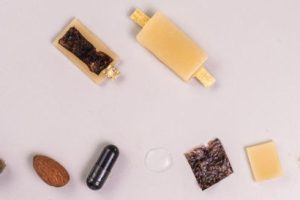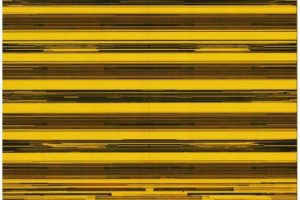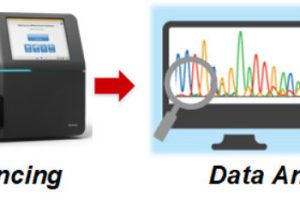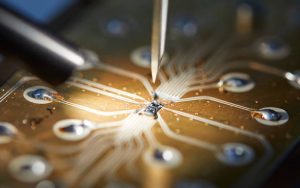
The challenge is to control the spins of electrons on many quantum dots simultaneously using the magnetic field of a microwave signal.
A wire running past qubits is one way to do it, according to the university, but range is limited so that many wires are needed to affect a field of qubits, leading to disruptive heat dissipation in the necessary cryogenic (below -270°C) environment.
The Sydney solution is to place a dielectric resonator over the top of a square array of qubits where it absorbs microwave energy and, shaped correctly, can push an even high-frequency magnetic field through all the quantum dots below simultaneously.
A rectangular block (0.7 x 0.55 x 0.3mm) of potassium tantalate (KTaO3) proved to be the answer for the scientist, with the material chosen for it high dielectric constant and low loss (therefore high-Q) at cryogenic temperatures.
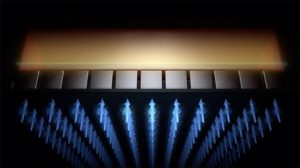
Its dimensions produce a magnetic pole down through the qubit array (artists impression left) loosely equivalent to a halo-like current loop floating over the quantum dots.
As it happens, the resonator itself pumped by a halo-like coaxial loop coupler in the vacuum above its top surface – the difference being that the resonator concentrates its local magnetic field many times more than the loop coupler can in a vacuum.
“The dielectric resonator shrinks the wavelength down below one millimetre, so we now have a very efficient conversion of microwave power into the magnetic field that controls the spins of all the qubits,” said Sydney engineer Dr Jarryd Pla, inventor of the technique. “There are two key innovations here. The first is that we don’t have to put in a lot of power to get a strong driving field for the qubits, which means we don’t generate much heat. The second is that the field is very uniform across the chip, so that millions of qubits all experience the same level of control.”
Separating the resonator and quantum dots is a 200μm sapphire spacer which reduces electric fields that might stray from the resonator to the dots, as well reducing Q-sapping coupling between the resonator and the substrate below the quantum dots.
Calculations suggest the magnetic field is uniform to better than 15% across a 200 x 200μm array, which could be improved by shape optimisation. That is enough area for four million qubits spaced at 100nm intervals.
“Removing the on-chip control wire frees up space for additional qubits and all of the other electronics required to build a quantum processor,” said fellow researcher Professor Andrew Dzurak. “It makes the task of going to the next step of producing devices with some tens of qubits much simpler.”
But don’t get too carried away: “There is still lots of engineering to be done to reliably manufacture millions of qubits,” counselled Dzurak.
The work is published as ‘Single-electron spin resonance in a nanoelectronic device using a global field‘ in Science Advances – full (clearly-written) paper can be viewed without payment.
 Electronics Weekly Electronics Design & Components Tech News
Electronics Weekly Electronics Design & Components Tech News

